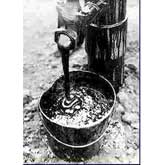Turning Oil Into Gas
 When you see all those cars at the gas station filling up with unleaded, you may not stop to think about how that gasoline got there. It wasn't pumped out of the ground in that form. The same goes for jet airplane fuel. It didn't start out that way--it took a long refining process to become fuel. You could never fly an airplane with gasoline, but the two products came from the same source: crude oil. Many petroleum products are used to make some sort of vehicle move: gasoline, diesel fuel, and jet fuel. Other products are made from petroleum, too. You might not be surprised to know that heating oil and asphalt are made from petroleum. But, what about crayons, floor polish, ice chests, mascara, volleyballs, guitar strings, roller skate wheels, bubblegum, and eyeglass frames? Most people don't realize that petroleum is the raw material for a lot more than gas.
When you see all those cars at the gas station filling up with unleaded, you may not stop to think about how that gasoline got there. It wasn't pumped out of the ground in that form. The same goes for jet airplane fuel. It didn't start out that way--it took a long refining process to become fuel. You could never fly an airplane with gasoline, but the two products came from the same source: crude oil. Many petroleum products are used to make some sort of vehicle move: gasoline, diesel fuel, and jet fuel. Other products are made from petroleum, too. You might not be surprised to know that heating oil and asphalt are made from petroleum. But, what about crayons, floor polish, ice chests, mascara, volleyballs, guitar strings, roller skate wheels, bubblegum, and eyeglass frames? Most people don't realize that petroleum is the raw material for a lot more than gas.
Crude oil comes out of the ground thick and dark, something like molasses. That's nothing like the gasoline that is pumped into your car! As it's refined, impurities are removed, and other products are allowed to settle out. There are three steps to the refining process: distilling, converting, and treating. Distilling: Oil is heated in large, tall towers. The extremely high temperatures break down the molecular chains of carbon in the oil, making it separate into layers. Heavier elements like sludge sink to the bottom, and the lighter gases such as propane float to the top. Suspended in the middle, you'll find the oil that will be made into gasoline and jet fuel. Just as cooking changes the characteristics of foods, 'cooking' the petroleum causes the oil to change its molecular structure, too. As the layers of light-to-heavy products separate, they're sent through pipes to different areas for further processing.
Converting: To convert oils, heavy hydrocarbon molecules are 'cracked' into lighter, smaller molecules. This is done by causing a reaction between the oil and hydrogen under high pressure and heat. Cracking breaks 70 percent of the petroleum into gasoline and the rest into diesel and jet fuel. The products are then blended with other products to create different octane levels of gasoline. Conversion finishes by rearranging the oil. To rearrange oil, hydrogen is removed from lower octane gasoline. Treating: Treating petroleum removes even more impurities, such as sulfur and nitrogen. These can cause air pollution. Nitrogen goes through a process called water washing, which transforms it into ammonia, and that is turned into farm fertilizer. After distilling, converting, and treating the crude oil, it is blended to create the finished products that we recognize. Blends of several products help make sure that the gas or fuel is the same every time.
Fact Credit
NASA Explores


